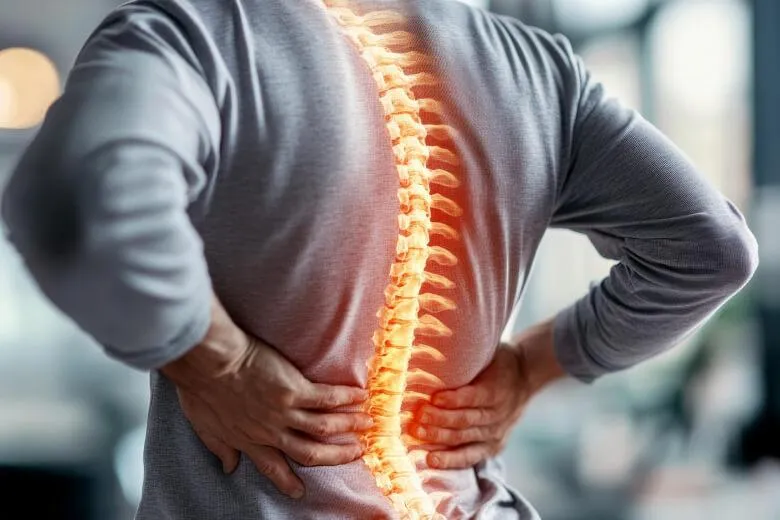
Back Strain Won’t Quit? Here’s Something Simple That Actually Works
Back strain has a way of sneaking into your life—and then refusing to leave.
Maybe it started after lifting something heavy. Or twisting the wrong way. Or maybe it just crept in slowly over time, showing up during long car rides or after standing too long at the sink. However it began, the outcome is the same: tight, aching muscles, a dull throb that never quite goes away, and that nagging fear that you’ll “throw your back out” again.
As a physician and someone who personally battled back issues for decades, I’ve seen this pattern over and over—and I lived it myself.
The good news? If your back strain just won’t quit, there’s a simple explanation. And an even simpler solution.
The Real Reason Your Back Won’t Heal
When we talk about “back strain,” we often picture muscles that are overworked or overstretched. And yes—strained muscles can hurt. But in my experience, persistent strain isn’t usually just a muscular problem.
It’s a stability problem.
Your muscles are trying to do a job they weren’t built for: holding your bones in place. Specifically, your pelvis.
When the bones of your pelvis shift even slightly out of alignment—often due to injury, pregnancy, repetitive strain, or weakened ligaments—the muscles of your lower back go into overdrive. They tighten to try to stabilize the area. And they stay tight. That’s why you feel like you need a massage every day… but the relief never lasts.
How I Discovered the Missing Piece
I had been practicing medicine for decades before I realized that my own recurring back strain wasn’t coming from my lumbar spine or a pulled muscle. It was coming from an unstable pelvis.
Once I understood that, I shifted my entire approach—from my own healing to how I treated my patients.
Instead of focusing on strengthening or relaxing the muscles, I focused on correcting what was making them tense in the first place.
And that changed everything.
Step 1: Realign the Pelvis
If your pelvis is even slightly off-kilter, your back muscles will work overtime to compensate.
A simple lunge-based stretch—done correctly and gently—can help reposition the pelvic bones and take pressure off the surrounding muscles and ligaments. Most of my patients felt a noticeable difference within minutes. One woman went from hobbling to walking upright during a single hike.
It’s not about cracking or forcing. It’s about giving the body the space and support to realign naturally.
Step 2: Wear the Right Support
Realignment is the first step—but if the ligaments around the pelvis are weak, your body may struggle to hold that alignment.
That’s where support comes in.
I recommend the a pelvic support belt, worn snugly across the hips (not the waist), during walking, lifting, or other active movement. It gives the pelvis the stability your muscles have been trying to provide on their own—so they can finally relax.
Step 3: Strengthen the Ligaments
Over time, if ligaments have been overstretched, they lose their ability to “snap back.” That’s why so many people with recurring back strain feel fine for a while—until the pain suddenly returns.
Prolotherapy—a regenerative injection treatment I’ve both used and administered—helps rebuild ligament strength naturally. It’s one of the most overlooked but powerful tools for long-term joint and back health.
But What About Muscle Pain?
Muscle strain is still real—and uncomfortable. A safe, topical anti-inflammatory cream can help ease daily soreness. I developed QR Cream for that very reason—so my patients could move with less discomfort while their bodies healed at a deeper level. The closer the muscles, ligaments, or tendons are to the skin surface, the more effective the cream is. The all-natural active ingredient, mannitol, travels from the skin surface to the nerves inside the ligaments that surround your joints or your muscle tendons, where it calms them down. The further it must travel, the more the body fluids will dilute it, and the less it will work.
Why This Works (When Other Things Don’t)
Most treatments for back strain focus on the pain. Stretch it. Massage it. Medicate it. But those don’t fix the cause.
This approach focuses on structure—on restoring proper alignment and support—so your body can do what it’s designed to do: heal.
If you’re tired of short-term fixes and endless cycles of strain, this may be the missing piece you’ve been looking for.
Let’s Recap:
Realign your pelvis gently with targeted movement
Support the area with a belt that takes the load off your muscles
Rebuild ligament strength to prevent future flare-ups
This isn’t a miracle. It’s simple, practical, and based on how your body actually works.
Want to See How It’s Done?
🎥 Register for my free webinar: Live Without Pain
I’ll share how I help patients reduce pain and support long-term healing—without drugs or surgery—and introduce a course that shows practical ways to find relief throughout the body.
Wishing you calm, comfort, and freedom of movement,
— Hélène Bertrand, MD (retired)
CLICK HERE TO RECEIVE LOW BACK PAIN RELIEF in 2 MINUTES!
Disclaimer: This content is for informational and educational purposes only and does not substitute professional medical advice, diagnosis, or treatment. Always consult your healthcare provider before starting any new treatment or making changes to your health regimen. Although Dr. Bertrand is a retired medical doctor, she is not practicing medicine or providing medical care through this website.
